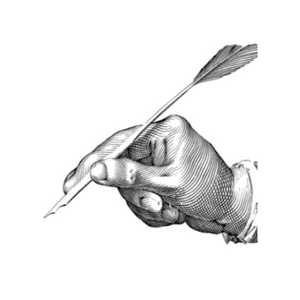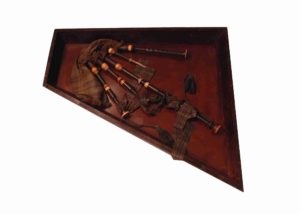Major-General David Stewart of Garth
Just before heading up the stairs to Gallery 4 visitors will see the painting of someone who, on first glance, might not look like a
Home » Blog » Black Watch History » Major Kathleen Laura Prendergast


Our Collections Assistant, Fiona, enjoys discovering forgotten stories from The Black Watch history and sharing these with our visitors today. In this blog she writes about an inspirational woman called Major Kathleen Prendergast.
As society continues to recognise the importance of diversity, the need for museums to represent as many voices as possible becomes more and more important. Within a museum like ours, this can be difficult since most of our collection and archive naturally focuses on the lives of white men. That’s why we like to shine the spotlight on those who fall out with this category; especially when the person is as remarkable as Katherine Prendergast. Not only was Katherine Prendergast’s work with The Black Watch a first for the British Army, she was is an example of a woman who was ground-breaking in her chosen fields and for her time.

As society continues to recognise the importance of diversity, the need for museums to represent as many voices as possible becomes more and more important. Within a museum like ours, this can be difficult since most of our collection and archive naturally focuses on the lives of white men. That’s why we like to shine the spotlight on those who fall out with this category; especially when the person is as remarkable as Katherine Prendergast. Not only was Katherine Prendergast’s work with The Black Watch a first for the British Army, she was is an example of a woman who was ground-breaking in her chosen fields and for her time. I first became aware of Major Prendergast from our Archivist, who mentioned that he heard of a rather formidable women who had served as the Medical Officer for the Regiment. Intrigued, I began digging through The Red Hackle magazine, looking for signs of her. It wasn’t long before I found a reference to a female medic who worked with The Black Watch in the late 1940’s with the surname Prendergast.
What then, made Kathleen Prendergast so significant? Appointed as Regimental Medical Officer to the 1st Battalion, The Black Watch in 1947, she was the first, and at the time of her death in 1954, the only female to hold this role in the British Army. Such was the admiration and respect for her within the Regiment; she remained in this role for over 5 years. This is despite the legend that her appointment was a practical joke played on the Commanding Officer! She was especially devoted to the Pipes and Drums and was given permission by Field-Marshal Lord Wavell, then Colonel of the Regiment, to wear the Red Hackle in her bonnet and a Black Watch tartan skirt.

There are many references to Kathleen within the Red Hackle Magazine during the years she served with the regiment, especially during their time in Germany. In 1947, it reports that she delivered the first baby born to a Black Watch married family serving within the British Army of the Rhine (The BAOR were the military force in the British controlled zone of occupied Germany following the end of the Second World War). The Red Hackle describes her as ‘Katie’, this being ‘the popular name for our popular M.O.’ she can also be seen in a group photograph of Officers taken in 1949.

Despite reluctantly having to transfer from the Regiment in 1952, Major Prendergast was to work with members of The Black Watch again when she treated Black Watch soldiers injured in Korea at Cowglen Military Hospital in Glasgow.
The medical and army career of Major Prendergast was extraordinary by itself, but it is only when you explore her entire life story that you realise just how special she was. I discovered this when I put her name into an internet search engine and came across an article called ‘The Mystery of the K. Prendergast Manuscript’. [1] This essay contained a wealth of information about her earlier life.
Born in Victoria, Australia on 19th November 1909, she had an accomplished academic career before coming to Europe. Having initially expressed an interest in medicine, she enrolled with the University of Western Australia to study geology and graduated in 1933 with a BSc with Honours. Finding it difficult as a woman to secure a position in fieldwork, she first qualified for the Diploma of Education in 1935; she then became the recipient of various studentships and scholarships. Specialising in palaeontology, she was awarded her PHD from the University of Cambridge in 1939. It is clear that Prendergast’s work in this field was greatly respected yet, despite there being evidence that she continued her research after her PHD, by 1944 she had qualified as a medical doctor. It is not known why she embarked on this dramatic career change although it is possible that the outbreak of the Second World War may have played a part in her decision.
Major Kathleen Prendergast died on 1st June 1954, having diagnosed herself 6 months earlier with lung cancer. She was 44 years old. Her long obituary, written in the 1954 July issue of The Red Hackle, gives an insight into her reputation within the Regiment and the fondness with which she was held. Describing her as ‘caustic, forthright, skilful, quarrelsome, devoted, friendly and passionately pro-Black Watch’, it states that ‘she quickly won the hearts of the unit’. A bearer party was supplied by the Depot and Pipe Major Hain of the 2nd Battalion played the lament at her funeral service. Many of her colleagues from The Black Watch attended, along with 3 of her former Commanding Officers. Her obituary reads ‘she is to be buried today in the presence of many members of the regiment with which she served, preceded by some of the pipes whose music was so dear to her.’
Had Major Prendergast been male, her academic and medical career would have been note-worthy. As a woman, however, in a time when it was difficult for a woman to pursue either of these roads, Kathleen Prendergast stands out as someone special.
[1] Squires D, Clarke M and Freshney, S., The Mystery of the K. Prendergast Manuscript, 2015, Papers and Proceedings of the Royal Society of Tasmania, 149, https://eprints.utas.edu.au/23591/7/02%20Squires%20et%20al.pdf
Just before heading up the stairs to Gallery 4 visitors will see the painting of someone who, on first glance, might not look like a

Rosie Waine is the William Grant Foundation Research Fellow at the National Museum of Scotland. Here she writes how the Black Watch Museum & Castle
The Black Watch Museum archive holds a considerable quantity of primary source material relating to the Battle of Loos, 24th September 1915. This event has
Subscribe to Our Newsletter
© The Black Watch Castle and Museum
The Black Watch Regimental Trust is a charitable company registered in Scotland | Charity No: SC005848
